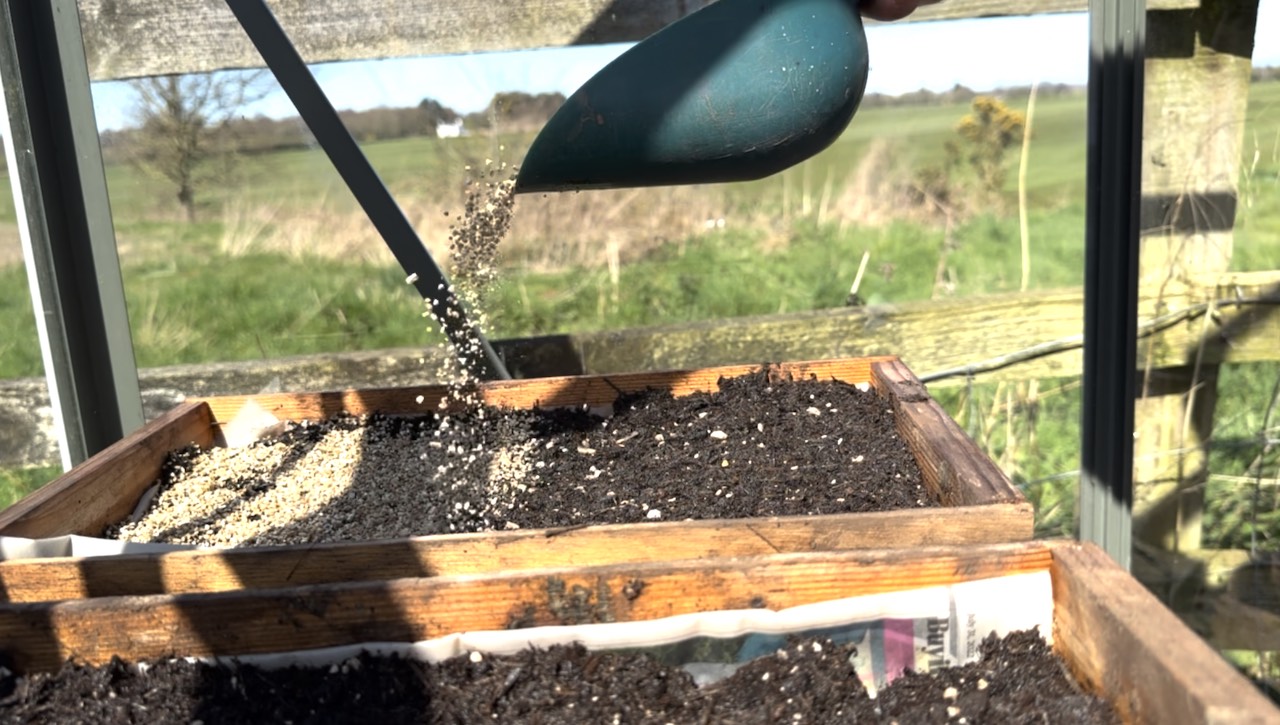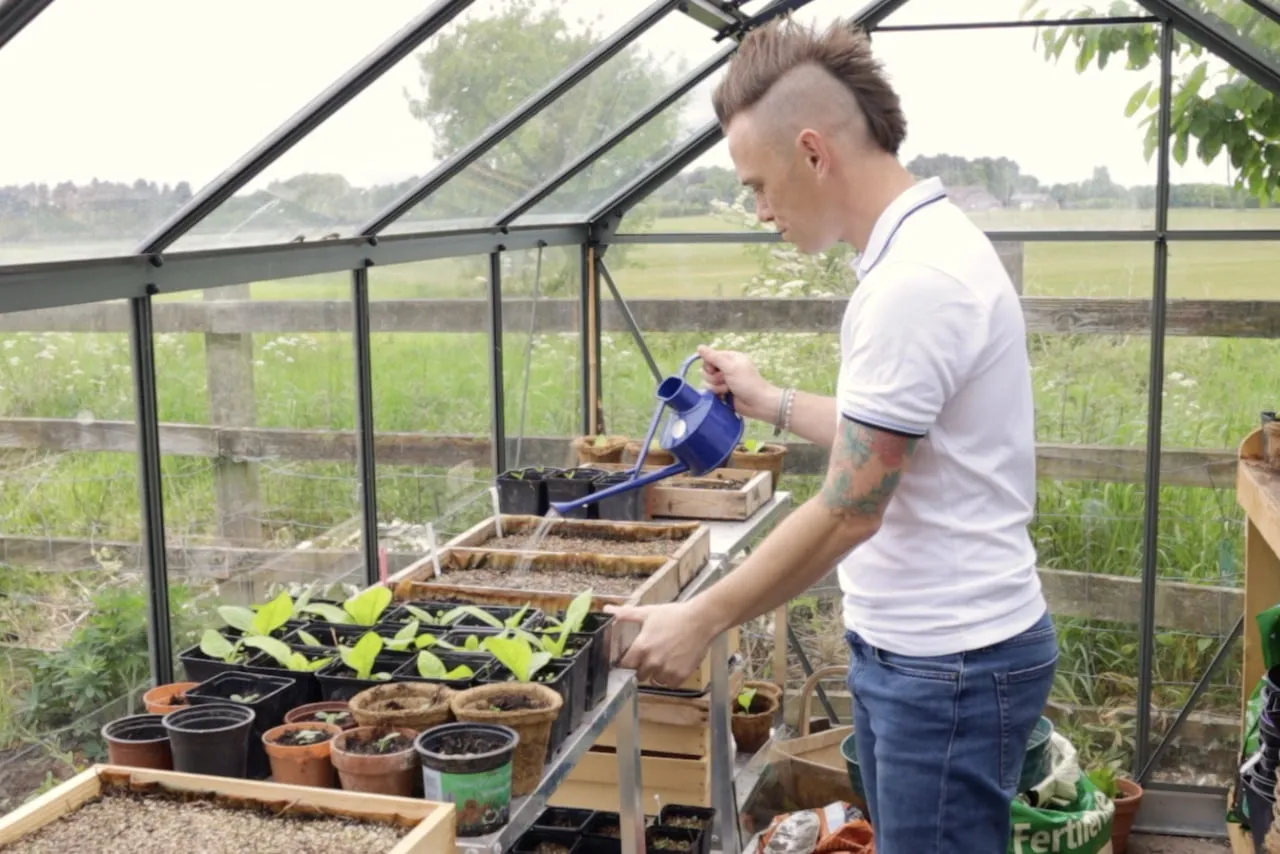Hi @tankboy74
Good to hear from you again! Yes it's that time of year to start sowing seeds and crossing fingers for germination!! Spring is always so exciting in the garden isn't it?
Ahh, the question of how to water seedlings without battering them or having to spend hours with trays and the like.
My preference when watering seedlings it speed. I'm always on the clock, usually 5 minutes before being late for something else. I live on espresso, adrenaline and the words 'Sorry I'm running 5 minutes late' during the spring months as I try to spin plates in both the garden and my design practice.
I don't have time for fussy bottom watering or immersing seed trays in troffs, etc. So my secret weapon is perlitte, that inert lightweight seed tray covering. I scatter a fine layer over seedlings so I can water from above with a small watering can with a fine rose, like this Hays watering can here.

To speed things up even more, at the beginning of the week, I fill some large trugs full of water from my water butt next to the greenhouse, and then I can dunk the mini watering can in for fast fill-ups. Then water gently from above with perlite, and there are no issues about seeds washing away or massive watering cans causing a seed compost tsunami!
Now you know which method I use at Garden Ninja HQ, let me just explain for other Ninjas what the difference is between top watering and bottom watering of young plants and seedlings.
What is Top Watering?
Top watering is exactly what it sounds like—watering from above using a watering can, hose, or misting system. It mimics natural rainfall, soaking the soil from the surface down. This is the most common way to water plants.
Pros of Top Watering
Cons of Top Watering
- Can displace seeds: A heavy flow of water can wash tiny seeds away before they sprout.
-
Encourages fungal diseases. Wet leaves and greenhouse humidity create a breeding ground for mold and damping off.
-
Inconsistent watering. The topsoil may be wet while deeper layers stay dry, leading to weak root systems.
https://youtu.be/VpIIaKM69eo
What is Bottom Watering?
Bottom watering involves placing seed trays in a shallow container of water, allowing the soil to soak up moisture from below through capillary action.
Pros of Bottom Watering
- Encourages strong root growth. Roots grow downward, seeking moisture, making plants more resilient.
-
Reduces fungal issues. Since leaves and stems stay dry, there's less risk of mold or damping off.
-
It provides even moisture. Water reaches all parts of the soil, preventing dry pockets.
Cons of Bottom Watering
- It takes longer. It can take 15-30 minutes for soil to fully absorb moisture.
-
There is risk of overwatering if trays sit in water too long; roots can become waterlogged, leading to rot.
-
It is not great for large seedlings. Bigger plants may need a top-up from above to ensure even hydration.
Hopefully, that helps. Let me know how you get on!
Lee Garden Ninja
Hi @tankboy74
Good to hear from you again! Yes it's that time of year to start sowing seeds and crossing fingers for germination!! Spring is always so exciting in the garden isn't it?
Ahh, the question of how to water seedlings without battering them or having to spend hours with trays and the like.
My preference when watering seedlings it speed. I'm always on the clock, usually 5 minutes before being late for something else. I live on espresso, adrenaline and the words 'Sorry I'm running 5 minutes late' during the spring months as I try to spin plates in both the garden and my design practice.
I don't have time for fussy bottom watering or immersing seed trays in troffs, etc. So my secret weapon is perlitte, that inert lightweight seed tray covering. I scatter a fine layer over seedlings so I can water from above with a small watering can with a fine rose, like this Hays watering can here.

To speed things up even more, at the beginning of the week, I fill some large trugs full of water from my water butt next to the greenhouse, and then I can dunk the mini watering can in for fast fill-ups. Then water gently from above with perlite, and there are no issues about seeds washing away or massive watering cans causing a seed compost tsunami!
Now you know which method I use at Garden Ninja HQ, let me just explain for other Ninjas what the difference is between top watering and bottom watering of young plants and seedlings.
What is Top Watering?
Top watering is exactly what it sounds like—watering from above using a watering can, hose, or misting system. It mimics natural rainfall, soaking the soil from the surface down. This is the most common way to water plants.
Pros of Top Watering
Cons of Top Watering
- Can displace seeds: A heavy flow of water can wash tiny seeds away before they sprout.
-
Encourages fungal diseases. Wet leaves and greenhouse humidity create a breeding ground for mold and damping off.
-
Inconsistent watering. The topsoil may be wet while deeper layers stay dry, leading to weak root systems.
What is Bottom Watering?
Bottom watering involves placing seed trays in a shallow container of water, allowing the soil to soak up moisture from below through capillary action.
Pros of Bottom Watering
- Encourages strong root growth. Roots grow downward, seeking moisture, making plants more resilient.
-
Reduces fungal issues. Since leaves and stems stay dry, there's less risk of mold or damping off.
-
It provides even moisture. Water reaches all parts of the soil, preventing dry pockets.
Cons of Bottom Watering
- It takes longer. It can take 15-30 minutes for soil to fully absorb moisture.
-
There is risk of overwatering if trays sit in water too long; roots can become waterlogged, leading to rot.
-
It is not great for large seedlings. Bigger plants may need a top-up from above to ensure even hydration.
Hopefully, that helps. Let me know how you get on!
Lee Garden Ninja
 Lee Burkhill: Award Winning Designer & BBC 1's Garden Rescue Presenters Official Blog
Lee Burkhill: Award Winning Designer & BBC 1's Garden Rescue Presenters Official Blog



